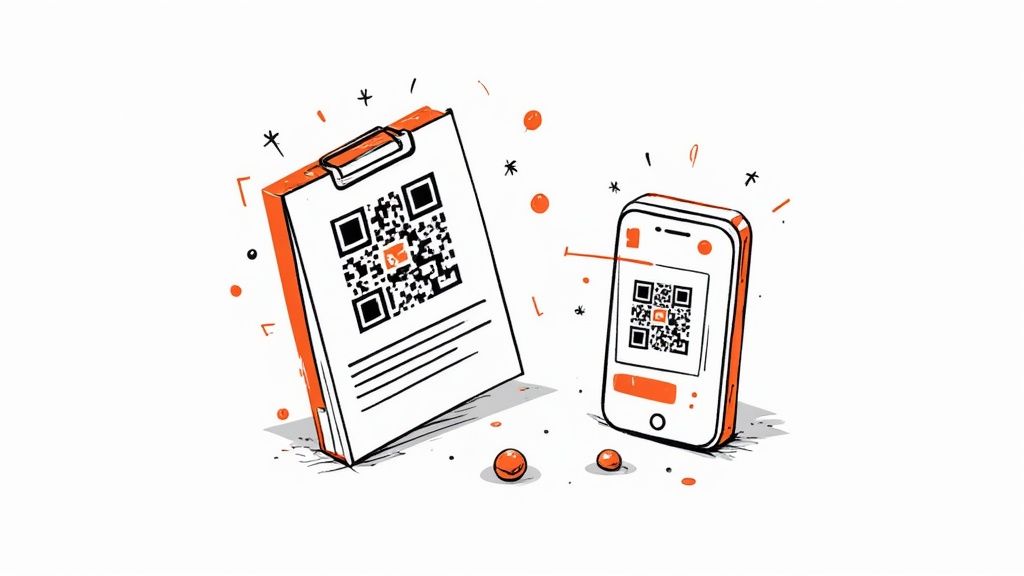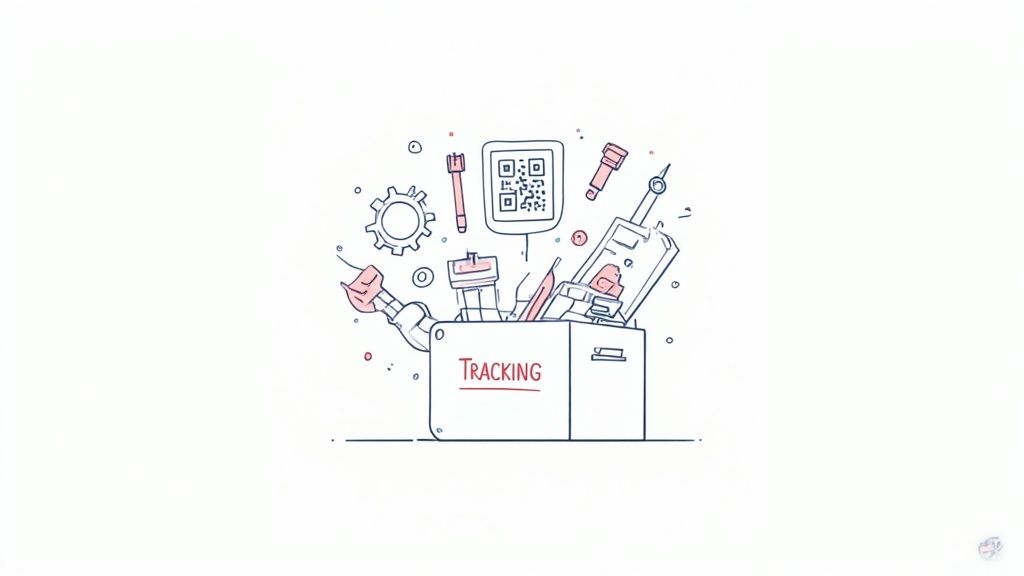Why Smart Marketers Are Obsessed With QR Analytics
Using QR codes without tracking is like navigating a maze blindfolded – you might stumble upon the exit, but it’s unlikely. For savvy marketers, QR code analytics aren’t just a nice-to-have; they’re essential.
Tracking transforms a basic QR code into a powerful tool for understanding your audience. Instead of just a total scan count, dynamic QR codes, combined with robust analytics platforms, tell a much richer story. This isn’t about collecting meaningless metrics. It’s about uncovering the levers that drive business growth:
- Which marketing materials get the most attention?
- What time of day are people scanning?
- Where are your most engaged customers located?
These insights allow you to fine-tune campaigns on the fly for maximum impact. With global QR code usage projected to skyrocket to 41.77 million scans in 2025, a 433% increase from just four years earlier, QR codes are becoming increasingly vital across all industries.

Building Your QR Tracking Foundation That Actually Works
Before diving into data analysis, you need a solid tracking setup. Think of it like building a house: a shaky foundation means trouble later on. This means picking the right QR code generator and structuring your tracking to grow with your campaigns.
The basic QR code tracking workflow involves:
- Creating a unique code.
- Placing it on your marketing materials.
- Watching the scan data roll in on your dashboard.
This simple foundation is crucial for any effective QR code campaign. Platforms like QR Star go beyond just pretty dashboards; they provide actionable insights, turning raw numbers into smart decisions.

Reading Your QR Data Like A Marketing Detective
Raw scan counts are just the beginning. The real value comes from understanding the context. Savvy marketers know how to analyze their QR code scan data to uncover hidden insights and optimize their strategies.
Let’s look at some real-world examples:
- Location Data: Imagine you’re running a promotion with QR codes on flyers across different neighborhoods. Analyzing scan data by location tells you which areas resonate most with your message. You can then double down on those high-performing locations for future campaigns, boosting your ROI.
- Timing is Everything: Are scans concentrated during lunch breaks? Weekends? Evenings? This tells you when your audience is most engaged. You can then schedule your social media posts or other digital promotions to coincide with these peak engagement times.
- Device Data: Are scans predominantly from iPhones or Android devices? This seemingly minor detail can inform your mobile optimization strategy, ensuring a smooth user experience for the majority of your audience. It can even influence decisions about platform-specific features or targeted advertising.
Tracking QR code scans isn’t about vanity metrics; it’s about understanding user intent. It’s about transforming raw data points into actionable insights that drive results. By identifying trends in scan timing, location, and device type, you can pinpoint what’s working, what’s not, and which metrics truly matter for long-term success.
Advanced Tracking Strategies From Marketing Pros
You’ve got the basics down, but how do the real marketing pros squeeze every drop of insight from their QR code campaigns? They use dynamic QR codes, clever segmentation, and powerful integrations.
- Dynamic QR Codes: Unlike static codes, dynamic QR codes aren’t locked to a single destination. They can change their linked URL based on various factors like time, location, or even the number of scans. For a flash sale, you could direct users to a specific landing page during the sale, then seamlessly redirect them to your regular product page once it ends. This keeps your codes relevant long after the initial campaign.
- Advanced Segmentation: Don’t just track total scans; find out who is scanning. Segment by location, time of day, device type, and even the specific campaign the code was part of. This granular view reveals which parts of your audience are truly connecting with your QR code efforts.
- Integrations: Connect your QR code tracking platform with your CRM (Customer Relationship Management) or marketing automation tools. Suddenly, you have a complete picture of the customer journey, from that initial scan to conversion. For example, if someone scans your QR code at a conference, a CRM integration can instantly add them to your mailing list and nurture that lead with targeted follow-up. This transforms a simple scan into a powerful lead generation machine.
The United States leads the world in QR code scans, accounting for a whopping 42.2% of the global total, with India trailing at 16.1%. This underscores the importance of mastering these advanced tracking techniques. Stay ahead of the competition by using dynamic QR codes, smart segmentation, and clever integrations.

Turning Your Scan Data Into Campaign Gold
Data without action is just noise. The real magic happens when you know how to use your scan data to make real improvements.
A/B Testing: A/B testing is a powerful way to put your data to work. If you’re promoting a new product, try creating two slightly different QR code versions (e.g., one simple design, one more eye-catching). Track scans for each version separately using unique UTM parameters. You might find that the visually appealing QR code gets more scans in print, while the simpler design performs better online. These insights help you optimize your QR code placement and design for each medium.
Timing is Everything: Analyzing scan data over time can unlock valuable insights. See a spike in scans on weekends? This tells you the perfect time to boost social media promotions or send out email blasts featuring your QR code. If scans dip during certain hours, you might adjust your paid ad scheduling to avoid wasting your budget
Creative Tweaks: Your QR code’s visual elements and surrounding call to action significantly impact scan rates. A QR code with a clear call to action like “Scan to get 20% off” will likely convert better than one with no explanation. By tracking scans and comparing different creative variations, you can fine-tune your messaging and design for maximum engagement.
Continuous Optimization: The key to maximizing your QR code campaign ROI is continuous optimization. Regularly review your scan data, spot trends, and make data-driven adjustments. This creates a feedback loop where your data informs your strategy, leading to better results. Don’t be afraid to pivot your campaign if the data suggests it!
Solving The Most Frustrating Tracking Problems
Even experienced marketers run into tracking issues. Here are some common headaches and their solutions:
Discrepancies Between Platforms: It’s frustrating when your QR Star dashboard shows different scan numbers than Google Analytics. Remember, these platforms track scans differently. QR Star usually captures the initial scan of the QR code itself. Google Analytics focuses on what happens on your website after someone scans the code and lands there. So, someone might scan your code (QR Star counts it) but then decide not to click through to your website (Google Analytics doesn’t count it). This difference is normal. Ad blockers and slow internet speeds can also affect analytics data.
Tracking Breaks: Imagine your dynamic QR code suddenly stops reporting data. This can happen if the link in your dynamic QR code breaks (e.g., the landing page URL changes, and you forget to update the code). Cached versions of your website on users’ devices can also cause issues. Regularly checking your QR codes and links is like preventative maintenance for your data. Test your QR codes often to ensure they’re sending users to the right place and tracking correctly in both QR Star and your integrated analytics platforms.
Scaling Across Multiple Channels: Tracking becomes challenging when your QR code campaign spans multiple channels—print, social media, email, and more. Are you using the same UTM parameters everywhere? Inconsistent tracking parameters can create a mess, making it hard to figure out which channels are actually performing well. Each QR code needs the correct UTM parameters to accurately attribute its scans. This detailed approach, using unique UTMs for each placement, lets you compare performance across different channels and make smart decisions about where to spend your marketing budget.

Your QR Tracking Success Action Plan
You’ve learned the ins and outs of QR code tracking. Now, let’s put it into action with a practical plan.
Setting Realistic Expectations and Timelines
You won’t become a QR code analytics expert overnight. It takes time to see meaningful data patterns. For short campaigns (e.g., a weekend sale), you’ll likely see results in a few days. For longer-term projects, give it a few weeks to gather enough data for significant trends. Patience is key!
Benchmarks for Measuring Your QR Tracking Triumphs
How do you know your tracking is actually working? Here’s what to look for:
- Consistent Data Across Platforms: Your QR Star dashboard and any integrated analytics tools (like Google Analytics) should tell a similar story. Small differences are fine, but big ones mean something’s off?
- Actionable Insights: Is your data actually helping you make marketing decisions? If it’s not informing your strategy, something needs adjusting.
- Smooth Scaling: As your campaigns grow, your tracking should handle the extra data without issues.
Avoiding Costly Tracking Mistakes: A Checklist
Here’s a quick checklist to keep your tracking on point:
- Unique UTM Parameters: Think of these as unique fingerprints for each QR code. They tell you exactly where your scans are coming from.
- Regular Testing: Scan your codes regularly. Make sure they work and send data to the correct places. This simple step can save you headaches later.
- Consistent Naming: Use clear and consistent names for your campaigns and UTM parameters. This keeps your data organized and easy to understand.
By following these tips, you’ll build a solid QR tracking system, avoid common problems, and turn your scan data into valuable insights. Ready to dive in and supercharge your marketing with QR Star?
Create, manage, and track your QR codes effortlessly. Get started with QR Star today!
